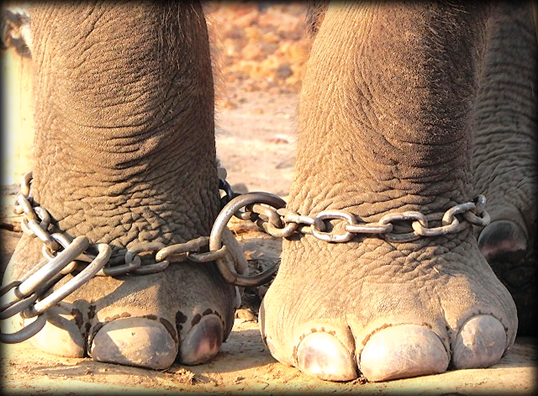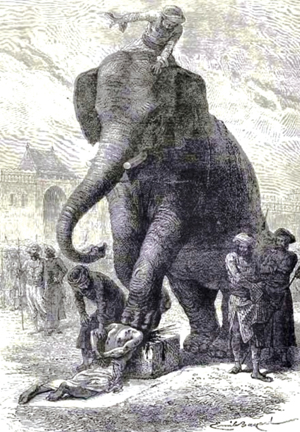Animals and culture - a Lankan perspective
By Jayantha Jayewardene
Culture is defined by some as the totality of socially transmitted
behaviour patterns, arts, beliefs, institutions, and all other products
of human work and thought. These patterns, traits, and products are
considered the expression of a particular period, class, community, or
population. (For example, the cultures of India or Sri Lanka).
Animal welfare refers to the action that ensures the well-being
mainly of domestic animals. Animal welfare was a concern of some ancient
civilisations but began to take a larger place in Western public policy
in 19th-century, as in Britain. Today it is a significant focus of
interest in science, ethics, and animal welfare organisations.
|

Chained feet |
According to the definition of culture, given above, many animals
possess cultures too; they are 'socially transmitted behaviour
patterns'. For example, migratory birds, carnivores that hunt
cooperatively and tool-using chimpanzees. Most 'cultural' associations
with animals in the eastern world are based on religion. In the western
world the associations are more symbolic.
Former Kings of Sri Lanka established some of the world's first wild
life sanctuaries. Five of the kings governed the country under the
Maghata rule, which banned completely the killing of any animal in the
kingdom. The five kings were 1) Amanda Gamini (79 - 80 AD), 2) Voharika
Tissa (269 - 291 AD) 3) Silakala (524 - 537 AD) 4) Agga Bodhi IV (658 -
674 AD) 5) Kassapa III (717 - 724 AD).
The standards of 'good' animal welfare vary considerably between
countries, tribes and even contexts. These standards are constantly
reviewed and are debated, created and revised by animal welfare groups,
legislators and academics all over the world.
Animal welfare science uses measures such as longevity, disease,
behaviour, physiology and reproduction. The mitigation of distress is
also a key component. There is however, constant debate about which of
these indicators provide the best information.
Concern for animal welfare is often based on the belief that
non-human animals are able to perceive or feel things and that
consideration should be given to their well-being or suffering,
especially when they are under the care of humans. These concerns can
include how animals are slaughtered for food, how they are used in
scientific research, how they are treated in captivity or in
domestication (as pets, in zoos, farms and circuses), and how human
activities affect the welfare and survival of wild species.
Sri Lanka is a predominantly Buddhist country with around 70 percent
of its population nominally subscribing to a Buddhist worldview. The
Buddha in his teachings has said, "One must not deliberately kill any
living creature either by committing the act oneself, instructing others
to kill, or approving of or participating in acts of killing. Completely
abstain from the act of killing directly and indirectly, eat only pure
vegetarian food".
In ancient times the State protected animals, birds, and other living
creatures of the land pursuant to a moving plea made by Arahath Mahinda
who brought the message of Buddhism to Sri Lanka from India. This plea
was made to King Devanampiyatissa during their very first encounter at
Mihintale about 2,300 years ago.
The plea was "Oh! Great King, the birds of the air and the beasts
have an equal right to live and move about in any part of this land as
thou. The land belongs to the peoples and all other beings and thou art
only the guardian of it." Based on these words, King Devanampiyatissa
established what is believed to be the world's first wildlife sanctuary.
As a result this is now a part of the traditional culture of Sri
Lankans who have always had an ethical (if not carefully rationalised)
concern for the welfare of animals and who revere all forms of life.
However, while a reverence for life is deeply entrenched in society,
this does not always translate to a reverence for welfare, which is
frequently rationalised as the karmic fate of the animal.
The paradox exists, therefore, that while most people will not kill
animals, they would not go out of their way to improve the wellbeing of
an animal, either. Examples include temple elephants being kept in
chains for much of the time or made to walk long distances on burning
hot paved roads; stray dogs being allowed to 'live' on roads and public
areas with little or no care. The state, which is constitutionally bound
to protect and foster the Buddha sasana, itself undertakes activities
that are arguably inimical to the welfare of animals, e.g., through a
fisheries corporation, a leather products corporation, a silk
corporation etc.
Veterinary ethics
Mahatma Gandhi has said "The greatness of a nation and its moral
progress can be judged by the way its animals are treated". Historical
rock inscriptions and ancient chronicles e.g. Mahawamsa, reveal that
state protection was granted to animals and the slaughter of cows was
strictly prohibited. However cattle bones feature prominently in
archaeological digs all over the country, including Anuradhapura.
Today veterinarians are required to be more than good at their
clinical work. They must have a sound understanding of their moral,
ethical and legal obligations to the public, their peers and the animals
that they treat.
Animal laws are now growing as a legal discipline. This has enormous
implications for the veterinary profession. With increasing public and
legal attention on issues of animal welfare, it is vitally important
that veterinarians have a clear understanding of their manifold duties.
The non-fulfillment of these duties places the veterinary profession
and its members at considerable risk, including public criticism and
legal liability.
We need to remove the culture of impunity and non-accountability in
respect to abuse of animals. Veterinarians should be called upon, as
part of good practical ethics, to report suspected abuse of animals as
much as the public should.
Sri Lanka's Animal Welfare Bill is now before the Cabinet of
Ministers before it becomes law. Many Asian countries will soon follow
with their legislation.
"Good laws should not be confined to the statute book or be allowed
to remain as a dead letter but should be enforced with the same spirit
with which it was enacted". However, the Bill should contain laws that
are enforceable.
Current Legislation
The following list is a catalogue of legislation that has a bearing
on Animals and Animal Welfare:
• The Prevention of Cruelty to Animals Ordinance, No.13 of 1907
• Animals Act, No.29 of 1958
• Fauna & Flora Protection Ordinance, No.2 of 1937 (Amended in 1997)
• Butchers Ordinance, No. 9 of 1893
• Animals Diseases Act, No.59 of 1992
• Municipal Council Ordinance, No.29 of 1947
• Urban Councils Ord. No.61 of 1939
• Pradeshiya Sabhas Act, No.15 of 1987
• Rabies Ordinance, No.7 of 1893
• Registration of Dogs Ordinance, No.25 of 1901
• Diseases of Animals Ordinance, No.25 of 1909
• Dangerous Animals Ordinance, No.38 of 1921
• Elephant Kraals Ordinance, No.1 of 1912
• Dried Meat Ord. No. 19 of 1908
• National Zoological Gardens Act, No.41 of 1982
Penal Code, No.2 of 1883
Elephants
In Sri Lanka, no other animal has been associated for so long with
the people in their traditional and religious activities as the
elephant.
This important cultural exploitation dates back to the pre-historic
era, more than 5,000 years ago. Elephants were often used in warfare,
with little concern for their wellbeing. It is not as if elephants
became associated with Buddhist culture because of some special
relationship: they just happened to be large, conveniently tameable
animals. No religious procession was complete without its retinue of
elephants, and many large Buddhist temples in Sri Lanka had their own
elephants as do private owners.
|

Crushing by elephant |
Ancient Sinhalese kings captured and tamed elephants, which used to
abound in the country, for various purposes. Elephants, suitably
caparisoned, have and still take part in ceremonial, cultural and
religious pageants and processions. Elephants have been used by man in
his wars in Europe and Asia. They have assisted him in his logging
operations and construction works.
They have also featured in various sports and combat during the
celebrations of the Sinhala community in Sri Lanka. They have helped in
timber operations and agricultural activities. In India they have
provided transportation for sportsmen indulging in shikars.
Historical records show that some ancient Sinhala Kings used
elephants to punish wrongdoers. One method was to get the elephant to
crush and dismember the victim
It is said that during the time of the Sinhala kings the elephant was
afforded 'complete protection' by royal decree.
This really only meant that their exploitation could be sanctioned
only by the king. This is not the same as what we mean by 'protection'
nowadays. The penalty for killing an elephant was death. With the advent
of the British to Sri Lanka this protection was withdrawn. On the
contrary large numbers of elephants were killed by the British under the
guise of sport.
Not only did the British government encourage and condone killing
elephants as a sport but it also paid a bounty for each elephant killed,
deeming the elephant an agricultural pest. Elephants were a common
element in Sinhalese heraldry for over two thousand years and remained
so through British colonial rule.
The coat of arms and the flag of the Ceylon Government from 1875 to
1948 included an elephant and even today many institutions use the Sri
Lankan elephant in their coat of arms and insignia - the Police
Department, Department of Wildlife Conservation, National Rugby Football
Union, Ceylon Government Railway etc.
[email protected]
(The writer is Managing Trustee, Biodiversity & Elephant Conservation
Trust
Sri Lanka)
To be continued
|

